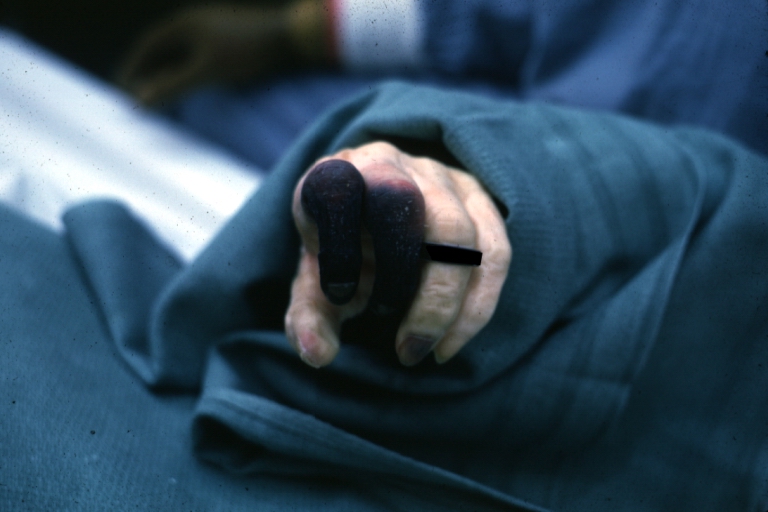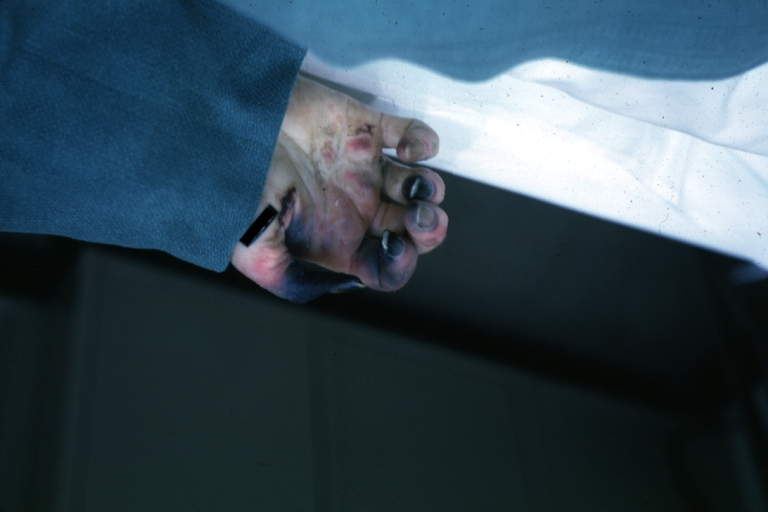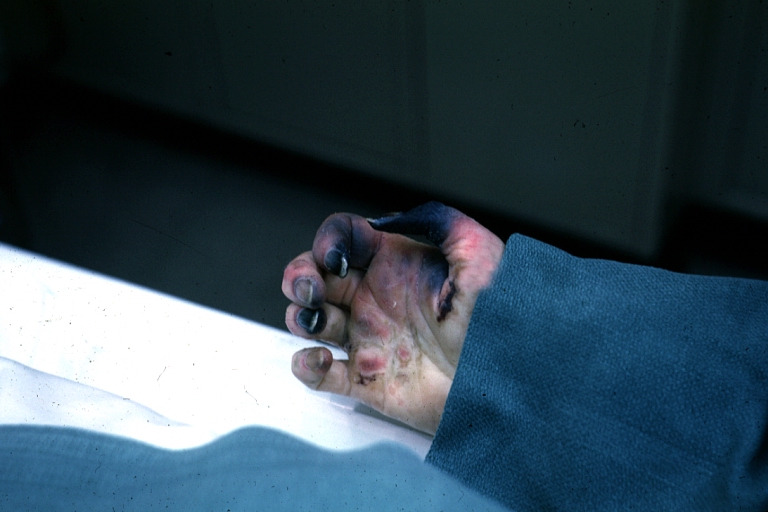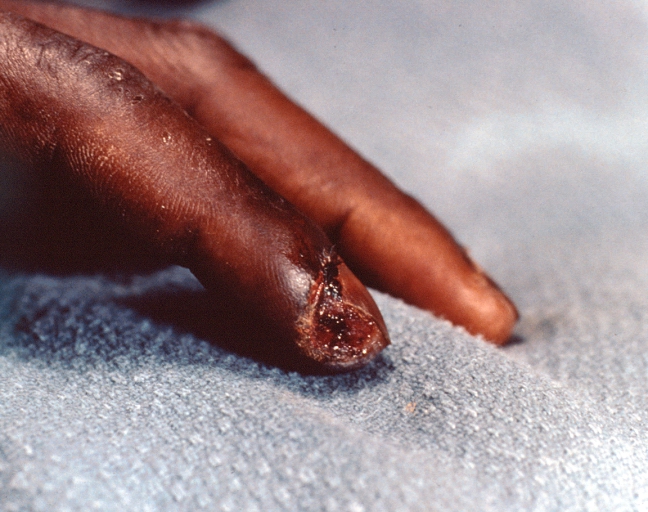Acral necrosis
| Acral necrosis | |
 | |
|---|---|
| A hand with acral gangrene due to plague |
|
WikiDoc Resources for Acral necrosis |
|
Articles |
|---|
|
Most recent articles on Acral necrosis Most cited articles on Acral necrosis |
|
Media |
|
Powerpoint slides on Acral necrosis |
|
Evidence Based Medicine |
|
Clinical Trials |
|
Ongoing Trials on Acral necrosis at Clinical Trials.gov Trial results on Acral necrosis Clinical Trials on Acral necrosis at Google
|
|
Guidelines / Policies / Govt |
|
US National Guidelines Clearinghouse on Acral necrosis NICE Guidance on Acral necrosis
|
|
Books |
|
News |
|
Commentary |
|
Definitions |
|
Patient Resources / Community |
|
Patient resources on Acral necrosis Discussion groups on Acral necrosis Patient Handouts on Acral necrosis Directions to Hospitals Treating Acral necrosis Risk calculators and risk factors for Acral necrosis
|
|
Healthcare Provider Resources |
|
Causes & Risk Factors for Acral necrosis |
|
Continuing Medical Education (CME) |
|
International |
|
|
|
Business |
|
Experimental / Informatics |
Editor-In-Chief: C. Michael Gibson, M.S., M.D. [1]; Associate Editor(s)-in-Chief: Ogheneochuko Ajari, MB.BS, MS [2]
Overview
Acral necrosis is the black discoloration of the skin of the extremities due to decreased blood supply to the afftected areas. Acral necrosis is a common symptom of bubonic plague.
Historical Perspective
The striking black discoloration of skin and tissue of the extremities is commonly thought to have given rise to the name Black Death, associated both with the disease and the pandemic which occurred in the 14th century. The term in fact came from the figural sense of "black", that is glum, lugubrious or dreadful.
Pathophysiology
Clotting and bleeding beneath the skin causes an area of hemorrhage, the presence of red blood cells lying outside of capillaries, into the skin and subcutaneous tissue. In isolation, this is called an ecchymosis or bruise and may be the result of injury or illness. However, acral necrosis occurs when blood supply is disrupted for prolonged periods, blackening and damaging the affected area and surrounding tissue.
Gross Pathology
-
Hand: Gangrene: Gross excellent demonstration of gangrenous necrosis of fingers
-
Hand: Gangrene: Gross excellent demonstration of gangrenous necrosis of fingers
-
Hand: Gangrene: Gross excellent demonstration of gangrenous necrosis of fingers
-
Necrosis of distal finger in a patient with panniculitis and fascitis, streptococcus A septicemia in a patient with Scleroderma who was on high dose steroids
Causes
Common Causes
Causes by Organ System
Causes in Alphabetical Order
Natural History, Complications and Prognosis
Untreated cases can lead to death.
Treatment
With appropriate medical treatment, areas with acral necrosis may be successfully restored to function.
References
- ↑ Van Beek N, Schumacher N, Haase O, Zillikens D, Kahle B, Schmidt E (2013). "[Primary antiphospholipid syndrome: newly developed leg ulcer and history of stroke.]". Hautarzt. doi:10.1007/s00105-013-2601-6. PMID 23744031.
- ↑ Jump up to: 2.0 2.1 Mactier RA, Stewart WK, Parham DM, Tainsh JA (1990). "Acral gangrene attributed to calcific azotaemic arteriopathy and the steal effect of an arteriovenous fistula". Nephron. 54 (4): 347–50. PMID 2325802.
- ↑ Stelzner C, Zimmermann F, Schellong SM (2012). "[Digital necrosis in a patient with atherosclerosis: also a paraneoplasia?]". Dtsch Med Wochenschr. 137 (15): 780–4. doi:10.1055/s-0032-1304914. PMID 22492412.
- ↑ Grünwald V, Bolte O, Wiebe S, Ganser A, Schöffski P (2005). "Acral necrosis after inadequate excessive administration of bleomycin in a testicular cancer patient". Onkologie. 28 (1): 41–3. doi:10.1159/000082054. PMID 15591723.
- ↑ Bär H, Pöhlmann G, Figulla HR (2000). "[Acute acral ischemia in all fingers possibly due to a Borrelia infection]". Vasa. 29 (4): 279–81. PMID 11141652.
- ↑ Sauter C, Saborowski A, Ockenfels HM (2007). "[Unilateral acral necrosis as a minor form of hand-foot syndrome. Patient with unilateral acral necrosis secondary to capecitabine therapy for metastatic breast cancer]". Hautarzt. 58 (7): 619–22. doi:10.1007/s00105-006-1227-3. PMID 17066280.
- ↑ del Giudice P, Lacour JP, Bahadoran P, Hoff-Bermond C, Ortonne JP (1995). "[Cutaneous necrosis of the extremities during carbon monoxide poisoning]". Ann Dermatol Venereol. 122 (11–12): 780–2. PMID 8729825.
- ↑ Scheinman PL, Helm KF, Fairley JA (1991). "Acral necrosis in a patient with chronic renal failure. Calciphylaxis". Arch Dermatol. 127 (2): 248–9, 251–2. PMID 1990994.
- ↑ Jansen TL, Janssen M, Janssens PM (2003). "Transient cryofibrinogenaemia with acral digital necrosis, secondary Raynaud's phenomenon and polyarthritis". Clin Exp Rheumatol. 21 (3): 407–8. PMID 12846071.
- ↑ Stussi G, Schneider E, Trüeb RM, Seebach JD (2001). "Acral necrosis of the fingers as initial manifestation of cutaneous polyarteritis nodosa--a case report". Angiology. 52 (1): 63–7. PMID 11205933.
- ↑ Holstein A, Bätge R, Egberts EH (2010). "Gemcitabine induced digital ischaemia and necrosis". Eur J Cancer Care (Engl). 19 (3): 408–9. doi:10.1111/j.1365-2354.2008.01057.x. PMID 19490003.
- ↑ Weichenhain B, Nerl C, Stiegler H (1994). "[Polyangiitis overlap syndrome]". Dtsch Med Wochenschr. 119 (17): 618–23. doi:10.1055/s-2008-1058738. PMID 8168423.
- ↑ DE Grip WJ, Bonting SL, Daemen FJ (1975). "Biochemical aspects of the visual process. XXXI. Chemical modification studies on rod outer segment retinol dehydrogenase". Exp Eye Res. 21 (6): 549–55. PMID NBK1283 Check
|pmid=value (help). - ↑ Süss R, Megahed M, Zumdick M, Glover M, Ruzicka T, Lehmann P (1996). "[Purpura fulminans with extensive skin necroses]". Hautarzt. 47 (7): 541–4. PMID 8926172.
- ↑ Silbernagel G, Schmalzing M, Riessen R, Koetter I (2010). "[Sepsis with acral necrosis in a patient with Sharp syndrome - case 8/2010]". Dtsch Med Wochenschr. 135 (36): 1741. doi:10.1055/s-0030-1247615. PMID 20812159.
- ↑ Pereira O, Velho GC, Lopes V, Mota F, Santos C, Massa A (2001). "Acral necrosis by Stenotrophomonas maltophilia". J Eur Acad Dermatol Venereol. 15 (4): 334–6. PMID 11730046.
- ↑ Distelrath K, Neuber K, Blödorn-Schlicht N, Altenhoff J, Dührsen U, Düring J; et al. (1999). "[Painful ischemia of the extremities with T-cell lymphoma]". Hautarzt. 50 (4): 284–7. PMID 10354922.



